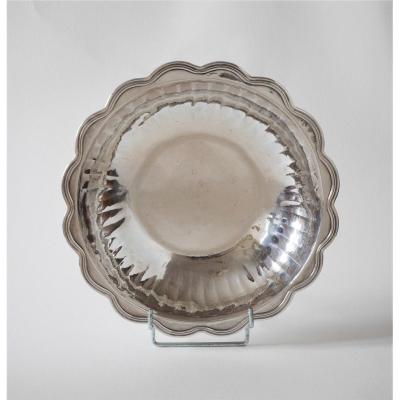"Round Bowl, Sterling Silver, Compiègne By Charles Huart, 1714-1726"
Hammered and melted silver
Compiègne, 1714-1726
By Charles Huart, received master silversmith in Paris for Compiègne in 1714, died in 1752
Good condition, wear and scratches from use, a small old weld (only visible on the back)
Dim: 24.8 cm diameter, height: 5 cm; weight: 272g
Round ribbed bowl with scalloped outline and filleted border
Often grouped in pairs, these shallow bowls were intended, according to inventories, for serving stewed or dry fruit and salads. This typical model of Paris and the neighboring regions was produced around the years 1710-1730. These bowls are classic elements of the French grand service. We find an identical bowl in the David David-Weill sale of November 24, 1971 n ° 45 by Nicolas Mahon (Paris, 1726) and in the collections of the Metropolitan Museum in New York by Philippe-Jacques Langlois (Paris, 1728-1729)
Hallmarks (on the molding): Master silversmith: C, H, a crescent, surmounted by a crowned fleur-de-lis [5]; Brand: hallmark unknown; Jurande: Crowned T, Compiègne, after 1714 before 1726 [Hallmarks not described]. The coin almanac gives the date 1667 for the establishment of the community of goldsmiths of Compiègne. It seems that the first hallmark of the mark was deposited in the court office on October 5, 1680 by the silversmiths an "A surmounting a clover", we can assume the use of a jurande hallmark since that date. In 1726, the lack of follow-up in the indictment of the hallmarks forced the Court to require the goldsmiths to appoint a guard, Charles Huart, to enforce the laws; a new punch of jurande "A crowned" is deposited on this occasion.
Charles Huart: born in Compiègne, Saint-Jacques parish, around 1682 to a master silversmith father named Florent, who died on January 1, 1688, and Antoinette de Billy. He comes from a family of goldsmiths, his uncle René and his older brother Jean are so designated on the death of his father. On March 21, 1714, he presented his masterpiece, a spoon, rue de Gesvres at the same time as Jacques Langlois. It is guaranteed by Joseph Tronchy, merchant in Paris and deposits its hallmark: C H, a crescent, surmounted by a fleur-de-lys with two grains. He died in Compiègne on March 27, 1752. Apart from the conservation of this bowl, no work of the goldsmith has been listed to this day.
Réf. : [1] Bimbenet-Privat, M. & Furing P. : «Orfèvrerie française, collection Jourdan-Barry», J. Kugel, Paris, 2005; [2] La Chapelle, Vincent : «Le cuisinier moderne», Paris, 1742; [3] Massialot, François : «Nouvelle instruction pour les Confitures, les Liqueurs et les Fruits », Claude Prudhomme, Paris, 1715 (Bnf. 8-S-9799); [4] Micio, Paul : «La Collection de Monsieur, frère de Louis XIV», Somogy Editions d’Art, 2014; [5] Nocq, Henry : «Le poinçon de Paris. Répertoire des maîtres-orfèvres de la juridiction de Paris depuis le Moyen-âge jusqu’à la fin du 18e siècle », 4 vol. Paris, 1926-1931

